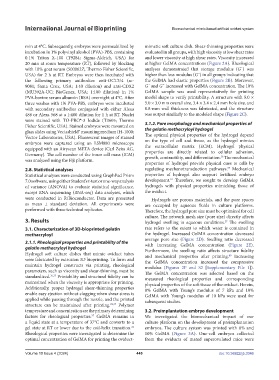Page 457 - IJB-10-4
P. 457
International Journal of Bioprinting Biomechanical mimic-based artificial oviduct system
min at 4°C. Subsequently, embryos were permeabilized by mimetic soft culture dish. Shear-thinning properties were
incubation in 1% polyvinyl alcohol (PVA)-PBS, containing evaluated in all groups, with high viscosity at low shear rates
0.1% Triton X-100 (T9284; Sigma-Aldrich, USA) for and lower viscosity at high shear rates. Viscosity increased
20 min at room temperature (RT), followed by blocking at higher GelMA concentrations (Figure 2A). Rheological
with 10% goat serum (500062Z; Thermo Fisher Scientific, analyses demonstrated that storage modulus (G´) was
USA) for 2 h at RT. Embryos were then incubated with higher than loss modulus (G˝) in all groups indicating that
the following primary antibodies: anti-OCT3/4 (sc- the GelMA had elastic properties (Figure 2B). Moreover,
9081; Santa Cruz, USA; 1:40 dilution) and anti-CDX2 G´ and G˝ increased with GelMA concentration. The 10%
(MU392A-UC; BioGenex, USA; 1:100 dilution) in 1% GelMA sample was used representatively for printing
PVA-bovine serum albumin (BSA) overnight at 4°C. After model shape to verify printability. A structure with 5.0 ×
three washes with 1% PVA-PBS, embryos were incubated 5.0 × 3.0 mm overall size, 3.4 × 3.4 × 2.4 mm hole size, and
with secondary antibodies conjugated with either Alexa 0.8-mm wall thickness was fabricated, and the structure
488 or Alexa 568 at a 1:400 dilution for 1 h at RT. Nuclei was output similarly to the modeled shape (Figure 2C).
were stained with TO-PRO®-3 Iodide (T3605; Thermo
Fisher Scientific, USA). Stained embryos were mounted on 3.1.2. Pore morphology and mechanical properties of
glass slides using Vectashield® mounting medium (H-1000; the gelatin methacryloyl hydrogel
Vector Laboratories, USA). Fluorescent images of stained The optimal physical properties of the hydrogel depend
embryos were captured using an LSM880 microscope on the type of cell and tissue, as the hydrogel mimics
equipped with an Airyscan META device (Carl Zeiss AG, the extracellular matrix (ECM). Hydrogel physical
properties are directly related to cellular adhesion,
Germany). The cell number of the inner cell mass (ICM) growth, contractility, and differentiation. The mechanical
38
was analyzed using the Fiji platform.
properties of hydrogel provide physical cues to cells by
39
2.8. Statistical analyses regulating mechanotransduction pathways. Mechanical
Statistical analyses were conducted using GraphPad Prism properties of hydrogel also support fertilized embryo
18
7.0 software, using either Student’s t-test or one-way analysis development. Therefore, we sought to develop GelMA
of variance (ANOVA) to evaluate statistical significance, hydrogels with physical properties mimicking those of
except RNA sequencing (RNA-seq) data analyses, which the oviduct.
were conducted in R/Bioconductor. Data are presented Hydrogels are porous materials, and the pore spaces
as mean ± standard deviation. All experiments were are occupied by aqueous fluids in culture platforms.
performed with three technical replicates. Therefore, the hydrogel pore size must be optimized for cell
culture. The network mesh size (pore size) directly affects
3. Results hydrogel swelling in aqueous conditions. The swelling
27
3.1. Characterization of 3D-bioprinted gelatin rate refers to the extent to which water is contained in
methacryloyl the hydrogel. Increased GelMA concentration decreased
3.1.1. Rheological properties and printability of the average pore size (Figure 2D). Swelling ratio decreased
with increasing GelMA concentration (Figure 2E).
gelatin methacryloyl hydrogel Furthermore, the swelling ratio affects structure fidelity
Hydrogel soft culture dishes that mimic oviduct tubes and mechanical properties after printing. Increasing
40
were fabricated by extrusion 3D bioprinting. To form and the GelMA concentration increased the compressive
maintain hydrogel constructs via printing, rheological modulus (Figures 2F and S2 [Supplementary File 1]).
parameters, such as viscosity and shear-thinning, must be The GelMA concentration was selected based on the
standardized. 36,37 Printability and structural fidelity can be measured rheological properties and corresponding
maintained when the viscosity is appropriate for printing. physical properties of the soft tissue of the oviduct. Herein,
Additionally, proper hydrogel shear-thinning properties 8% GelMA with Young’s modulus of 7 kPa and 10%
enable easy ejection without clogging when shear stress is GelMA with Young’s modulus of 10 kPa were used for
applied while passing through the nozzle, and the printed subsequent studies.
structure can be maintained after printing. 22,37 Polymer
temperature and concentration are the primary determining 3.2. Preimplantation embryo development
factors for rheological properties. GelMA remains in We investigated the biomechanical impact of our
37
a liquid state at a temperature of 37°C and converts to a culture platform on the development of preimplantation
gel state at RT or lower due to the coil-helix transition. embryos. The culture system was printed with 8% and
21
Rheological properties were investigated to determine the 10% GelMA (Figure 3A). One-cell embryos collected
optimal concentration of GelMA for printing the oviduct- from the oviducts of mated superovulated mice were
Volume 10 Issue 4 (2024) 449 doi: 10.36922/ijb.3346

